
A diesel multiple unit or DMU is a multiple-unit train powered by on-board diesel engines. A DMU requires no separate locomotive, as the engines are incorporated into one or more of the carriages. Diesel-powered single-unit railcars are also generally classed as DMUs. Diesel-powered units may be further classified by their transmission type: diesel–mechanical DMMU, diesel–hydraulic DHMU, or diesel–electric DEMU.
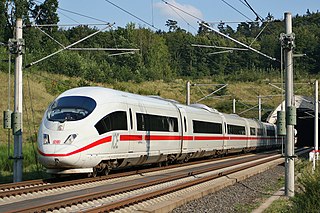
A multiple-unit train is a self-propelled train composed of one or more carriages joined, and where one or more of the carriages have the means of propulsion built in. By contrast, a locomotive-hauled train has all of the carriages unpowered.

A railbus is a lightweight passenger railcar with an automotive engine. It shares many aspects of its construction with a bus, typically having a bus body and four wheels on a fixed base instead of on bogies. Originally designed and developed during the 1930s, railbuses have evolved into larger dimensions with characteristics similar in appearance to a light railcar, with the terms railcar and railbus often used interchangeably. Railbuses designed for use specifically on little-used railway lines were commonly employed in countries such as Germany, Italy, France, the United Kingdom, and Sweden.
Push–pull is a configuration for locomotive-hauled trains, allowing them to be driven from either end of the train, whether having a locomotive at each end or not.

The Sri Lanka Railway Department is Sri Lanka's railway owner and primary operator. As part of the Sri Lankan government, it is overseen by the Ministry of Transport. Founded in 1858 as the Ceylon Government Railway, it operates the nation's railways and links Colombo with other population centres and tourist destinations.

The Kelani Valley railway line in Sri Lanka, covering the breadth of Colombo District. The line is owned, maintained, and operated by Sri Lanka Railways.

The Main Line is a major railway line in the rail network of Sri Lanka and considered by many to be one of the most scenic train journeys in all of Asia. The line begins at Colombo Fort and winds through the Sri Lankan hill country to reach Badulla.

Sri Lanka Railways S12 is a class of Diesel-electric multiple unit (DEMU) built for Sri Lanka Railways by China's CSR Corporation. The first batch arrived in Sri Lanka in August 2012. They were built to replace locomotive-hauled passenger trains. Seven of the S12 DMUs were ordered to strengthen long-distance travel on the Main line from Colombo to Badulla. Four of S12s were built to serve the Kelani Valley Line. The remaining set was designed as a luxury train.

Sri Lanka Railways S8 is a class of Diesel multiple unit (DMU) train set made by Hitachi and Hyundai operated by Sri Lanka Railways. They were imported to Sri Lanka in 1991 and primarily runs on the Kelani Valley Line.

Class M7 is a type of diesel-electric locomotive built for Sri Lanka Railways by Brush Traction, UK, and imported in 1981. This locomotive has the shortest length, least power and least weight compared to other diesel locomotives of Sri Lanka.
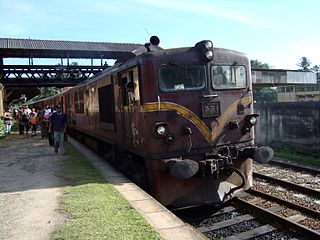
The Sri Lanka Railways Class M5 is a type of diesel-electric locomotive. The class was ordered to strengthen the diesel locomotive fleet of Sri Lanka Railways.
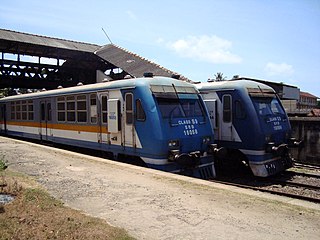
Sri Lanka Railways S9 is a class of diesel-electric multiple unit (DEMU) train sets operated by Sri Lanka's state run rail operator, Sri Lanka Railways.
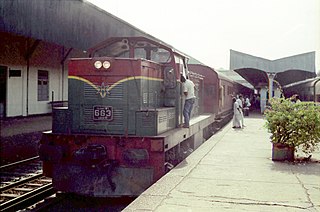
Sri Lanka Railways W1 is a class of Sri Lankan diesel-hydraulic locomotive that was built by Rheinstahl Henschel in 1969 for use by Sri Lanka Railways (SLR). This is the first diesel-hydraulic locomotive to run on Sri Lankan rails.

The Sri Lanka Railways W2 is a class of diesel-hydraulic locomotives built by LEW Hennigsdorf for Sri Lanka Railways.

Sri Lanka Railways S5 is a class of Diesel multiple unit (DMU) train set built by Hitachi and introduced to Sri Lanka between 1969 and 1970, only two of which were imported. The class was built with modern interior facilities aimed towards the special train tours market and is operated by Sri Lanka Railways.
Ceylon Government RailwayS1 was a class of Diesel multiple unit train sets built by English Electric for the Ceylon Government Railway.

An electro-diesel multiple unit (EDMU) or bi-mode multiple unit (BMU) is a form of a multiple unit train that can be powered either by electric power picked up from the overhead lines or third rail or by using an onboard diesel engine, driving an electric generator, which produces alternating current (AC) or direct current (DC) electric power.

The Indian locomotive class WDM-3D is a class of diesel–electric locomotive that was developed in 2003 by Banaras Locomotive Works (BLW), Varanasi for Indian Railways. The model name stands for broad gauge (W), Diesel (D), Mixed traffic (M) engine with 3300 horsepower (3D). The engine is classified WDM-3D though it outputs only 3300 hp and not 3400 hp as the name should suggest. They entered service in 2003. A total of 590+ WDM-3D were built at Banaras Locomotive Works (BLW), Varanasi between 2003 and 2016.
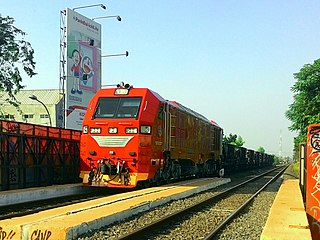
The INKA CC300, also known in the Philippines as the PNR 9000 Class, is a multipurpose Diesel-hydraulic locomotive owned by Directorate General of Railways and built by Indonesian state-owned rolling stock manufacturer PT INKA. Launched in 2013, it is the first mainline locomotive wholly produced by Indonesia and the first locomotive exported by Indonesia to another country, when the Philippine National Railways (PNR) received its first set of INKA CC300 locomotives in December 2020.
A multiple-unit train or simply multiple unit (MU) is a self-propelled train composed of one or more carriages joined together, which when coupled to another multiple unit can be controlled by a single driver, with multiple-unit train control. Although multiple units consist of several carriages, single self-propelled carriages, such as railbuses and trams – are in fact multiple-units when two or more of them are working connected through multiple-unit train control.





















